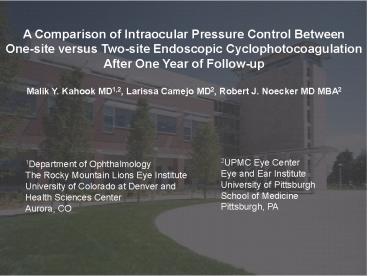A Comparison of Intraocular Pressure Control Between - PowerPoint PPT Presentation
1 / 10
Title:
A Comparison of Intraocular Pressure Control Between
Description:
... Control Between. One-site versus Two-site Endoscopic Cyclophotocoagulation ... of endoscopic cyclophotocoagulation (ECP) treatment ... – PowerPoint PPT presentation
Number of Views:35
Avg rating:3.0/5.0
Title: A Comparison of Intraocular Pressure Control Between
1
A Comparison of Intraocular Pressure Control
Between One-site versus Two-site Endoscopic
Cyclophotocoagulation After One Year of
Follow-up Malik Y. Kahook MD1,2, Larissa Camejo
MD2, Robert J. Noecker MD MBA2
2UPMC Eye Center Eye and Ear Institute University
of Pittsburgh School of Medicine Pittsburgh, PA
1Department of Ophthalmology The Rocky Mountain
Lions Eye Institute University of Colorado at
Denver and Health Sciences Center Aurora, CO
2
Dr. Noecker is on the speakers Bureau of
EndoOptiks. Drs. Kahook and Camejo have no
financial disclosures
3
Purpose To report the intraocular pressure
(IOP) lowering effect of endoscopic
cyclophotocoagulation (ECP) treatment through
one versus two corneal incisions after one year
of follow-up.
4
Methods This is a retrospective consecutive
case review of combined ECP and
phacoemulsification (PE). Group 1 included
patients undergoing PE-ECP through one clear
cornea incision and Group 2 involved PE followed
by ECP through two incisions. Data including
age, sex, pre-operative diagnosis, number of pre
and post-operative glaucoma medications,
complications, and IOP were collected and
analyzed using analysis of variance (ANOVA) and
t-tests where appropriate.
5
Methods (continued) First, phacoemulsification
was performed through a clear cornea incision
followed by placement of a posterior chamber
intraocular lens (PCIOL). A curved ECP probe was
then introduced through the clear cornea
incision and 270-300 degrees of ciliary processes
(CP) were treated at a power of 0.25 W. A
second clear cornea incision (see figure 1) was
then created supranasally in order to access the
subincisional CP. The remaining 60-90 degrees
of CP were then treated followed by irrigation
and aspiration to remove the remaining
viscoelastic. The wounds were hydrated until
water tight after inflation of the anterior
chamber to physiologic pressure.
6
White arrows Site of first clear cornea
incision Yellow arrow Site of second clear
cornea incision used to treat ciliary processes
under initial incision. Blue arrow Edge of
PCIOL with iris lifted off of subincisional
anterior capsule and ciliary processes.
7
Results Group 1 included 18 patients and Group
2 included 30 patients. Age of patients in
group 1 (68.30 /-15.52) and group 2 (72.78
/-13.22) were similar (p0.29). Group 1
included 10 males and 8 females. There were 14
cases of open angle glaucoma, 2 cases of
pseudoexfoliative glaucoma, and 2 cases of low
tension glaucoma. Group 2 included 11 males
and 19 females. There were 22 cases of open
angle glaucoma, 3 cases of pseudoexfoliative
glaucoma, 2 cases of low tension glaucoma, 2
cases of pigmentary glaucoma, and 1 case of
neovascular glaucoma.
8
Results (continued) Pre-operative IOP was
25.60 /-3.51 in group 1 and 23.48 /-7.31 in
group 2 (p0.26). IOP decreased in group 1 to
16.93 /-3.27 (plt0.001) and in group 2 to 14.12
/-3.01 (plt0.001) with one year of
follow-up. IOP at one year was significantly
lower in group 2 compared to group 1 (p0.004).
Change in post-operative glaucoma medication
use from baseline was significantly lower in
group 2 (2.81 /-0.83 to 0.67 /-0.39) versus
group 1 (2.26 /- 0.91 to 1.90 /-0.73)
(plt0.001).
9
Conclusions Two-site PE-ECP may result in
more statistically significant IOP lowering and
less dependence on glaucoma medications compared
to single site PE-ECP after one year of
follow-up.
10
Malik Kahook, M.D. is an Assistant Professor of
Ophthalmology and Director of Clinical Research
at the Rocky Mountain Lions Eye Institute in
Aurora Colorado. He specializes in the medical
and surgical care of glaucoma and cataracts.
Research interests include imaging of the eye,
laser surgery for glaucoma, protein markers of
ocular disease, improving adherence/compliance to
therapy, and both clinical and basic science
pharmacology studies.































